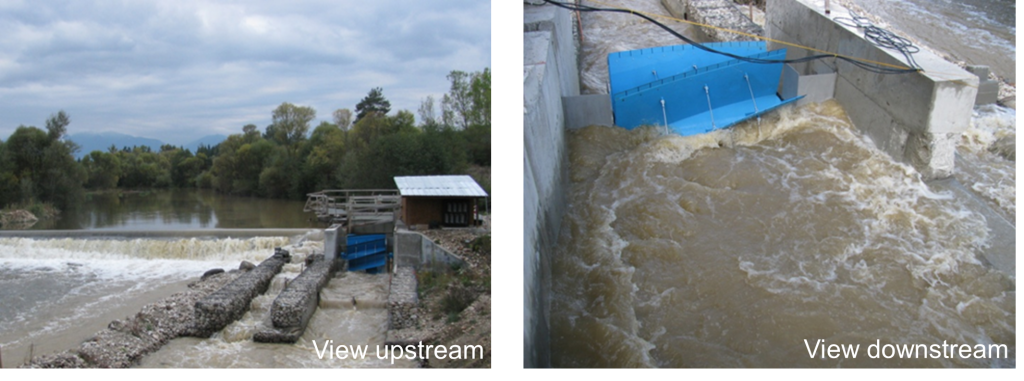Resource and requirement
- Unused low head potential in England: 800 → 1000 MW
- From old mills and river weirs, (~ 30,000 mills were in operation in the 1850’s)
- Global resource available from run of river sites to irrigations canals
- No economically viable very low head and high flow rate machine currently available
- New requirement for an economic and ecologically acceptable turbine
Concept – Hydrostatic Pressure Machine (HPM)
Members of the sustainable energy research group (Gerald Muller, James Senior, Nick Linton and William Batten) have been involved in the design and development new machine.
This new machine developed at Southampton University, uses hydrostatic pressure difference. It is a simple machine which can feasibly take a high volume of flow and also also fish as sediment passage.
The further development and field demonstrations has been a part of the HYLOW project.
Theory
The novel principles:
- Wheels acts as weir and maintains head difference
- Hydrostatic pressure acts on moving wheel blade
- Pressure head reduces with increasing wheel speed
- Losses caused by turbulence, and leakage
Theoretical properties:
- Efficiency reduces with increasing flow rate (Q)
- Maximum efficiency does not coincide with max. power
- Flow volumes Q = 2 m³/s • m
- Power: 5 → 150 kW
- Efficiencies: 70 → 85%
Lab model experiments
Lab scale model:
- Most tests done at 1:6 scale
- 12 bladed machine
- Used to further develop theory and design field installations
Parameters tested:
- Hub to diameter ratio
- Blade shape / angle
- Machine to channel width
- Shoe shapes
Field demonstration (1) Reactivation of old mill
(A) Retrofit of an old mill to generate electricity
(B) Inclined blades, steel runner with concrete support structure
Measured performance
- Mech. efficiency: 80%
- Total eff. (hydro → elec): 65%
- Measurements agree well with theory
Advantages:
- Economical
- Ecologically compatible allows for sediment and fish passage
- Retrofit possible
Field demonstration (2) Run of river installation
Performance
- Pmax = 12 kW (elec.)
- H = 1.00 m
- Q = 1.80 m³/s
- Max. eff. hydro→ elec: 77% ~ 60% design flow
Further details
- Senior, J., Muller, G.U. and Wiemann, P. (2007) The development of the rotary hydraulic pressure machine. In, 32nd IAHR Conference 2007, Venice, Italy, 01 – 06 Jul 2007.
- Senior, James, Saenger, Nicole and Muller, Gerald (2010) New hydropower converters for very low-head differences. Journal of Hydraulic Research, 48, (6), 703-714.(doi:10.1080/00221686.2010.529301 ).




